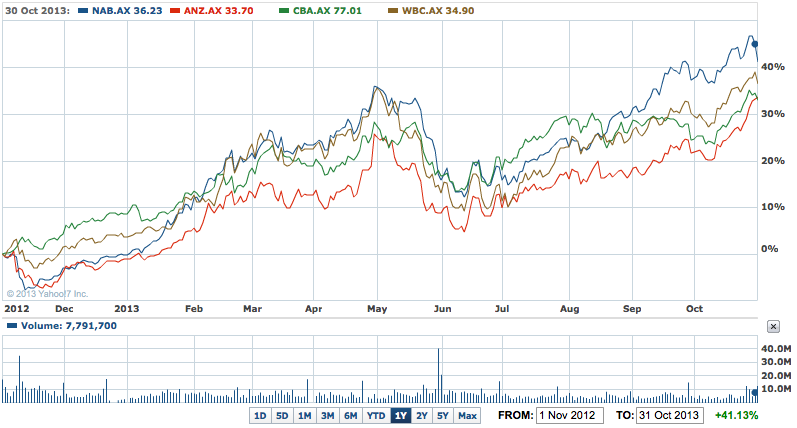Unlike the reaction to the ANZ profit earlier this week, investors failed to give a positive welcome to the full year results from NAB, with shares in the bank falling close to 4% at one stage yesterday after it revealed a 9% rise in cash earnings and a higher dividend.
The shares recovered as trading continued through the day, with a boost from a positive performance by CEO Cameron Clyne at media and analyst briefings.
The shares ended down 2.5% or 92c at $35.31.
That still left them close to six year highs, as opposed to the recent all time peaks hit by the Commonwealth, Westpac and ANZ (all this week).
By way of contrast, the ANZ shares rose on Tuesday and again in Wednesday’s sell-off, so the market reaction to the NAB result was definitely more cautious.
Investment analysts said the 9% rise in the cash profit to $5.94 billion was solid, but pointed to a $618 million fall (23%) in the bank’s bad and doubtful debts charge to $1.9 billion. That boosted profits considerably.
It was still well under the ANZ’s cash profit of $6.498 billion. It is nearly $2 billion under the Commonwealth’s result for its June 30 year. The NAB had a return on equity of 14.5%, under the ANZ’s 15.3%.
And while the ANZ also saw a fall in its bad and doubtful debts charge, it wasn’t as large as that enjoyed by the NAB, which was helped by improved trading conditions for its weak UK banking business. The bank actually reported a rise in new asset impairment figures for Australia for the year.
Over the year there was a small rise in the bank’s cost to income ratio (because revenue growth was at 2% to $18.5 billion).
The ratio ended the year at an average of 42.6%, up from 41.3%. But it jumped from 41.7% at the end of March to 43.4% at the end of September, which raised eyebrows among banking analysts.
Investors will receive a final dividend of 97c a share, 7c more than last year, taking distributions for the full year to $1.90.
That’s a payout ratio of 75.1% of net profit, (down from 76% a year earlier) which is where the other banks are.
That tells us that the APRA edict to put a limit on dividends (and no cash return payments) is in place.
The Big 4 YTD – NAB does OK, market not really certain

The result is broadly in line with market expectations of a full-year cash profit of $5.95 billion.
Group revenue rose 2%, helped by rising housing lending in Australia and New Zealand which saw the NAB grab market share from competitors.
"The group’s full year results show an improved performance across most business units, combined with solid progress against our simplification and digitisation agenda,” Mr Clyne said in a statement.
“Some improvement in the UK operating environment and initiatives to reduce the Australian risk profile have supported a lower charge for [bad and doubtful debts].
“Personal banking again produced a strong result on the back of good momentum in housing lending and increased customer deposits."
The result in this business rose 17.5% to $1.2 billion.
Interestingly, Mr Clyne said 62% of the NAB’s home mortgage holders were repaying their loans faster than they had to and were an average eight repayments ahead of where they should be.
Reserve Bank figures suggest that mortgage holders are 21 months ahead of schedule, so the NAB is well under that level.
But that could also reflect the bank’s aggressive market share grab in home lending, meaning it has a higher proportion of home loans of a younger vintage than some of its competitors.
It could also reflect a higher proportion of investors who don’t have the same need to repay loans faster than they should.
Mr Clyne said the improving health of the UK economy, and the bank’s restructuring of its UK business had boosted performance in the year.
The loss in the business holding poor quality commercial property loans narrowed sharply to 90 million pounds, while earnings elsewhere in the UK rose 34% to 55 million pounds.













